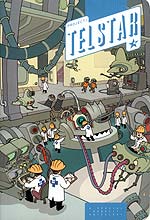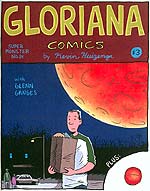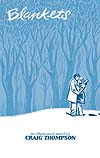 "Kramer's Ergot" number 4
"Kramer's Ergot" number 4 |
While the festival included some presentations — one was on the history of underground comix, another featured Art Spiegelman — the publisher's ballrooms are the reason everyone shows up. Because the festival excludes mainstream and "genre" houses, the publishers who concentrate on singular artistic visions get a targeted demographic to die for. Consequently sales for these oftentimes one-woman operations far exceed those at most other conventions. Filled with interesting and often hard-to-find singularities, it becomes the best comicbook store in America for one day. So now it's getting crowded.
 Jonathan Bennett's "Esoteric Tales"
Jonathan Bennett's "Esoteric Tales" |
"The festival is not going to stay the same," says Lawrence Klein, chairman of MOCCA, which stands for Museum of Comic and Cartoon Art. Founded in 2001 as a non-profit, MOCCA's stated purpose is the "collection, preservation, study, education, and display of comic and cartoon art." Currently headquartered in Manhattan's Union Square, MOCCA hopes to eventually open a museum, possibly downtown in the recovering World Trade Center area, though no exact location or opening date have been announced. For now they fulfill their mission by organizing spot exhibits around New York and putting together the annual art festival. But now it has to change.
For one thing the Harvey Awards, the other annual industry awards besides the Eisners, will now be given out at the festival. This is a monumental improvement over the Harvey's last home at the Pittsburgh Comicon, of all things. Consequently, says Lawrence Klein, the awards will be on Saturday night and the festival will be on Sunday. But other changes may take place as well, according to Klein. The success of the festival has begun to challenge the capacity of the Puck building for a single day. The show may move to another venue and they may make it into two full days Klein says. The potential move has caused some concern among the participants, though. The Puck has a charm sorely lacking at the affordable, mid-level hotels. But the most controversial change would be the inclusion of mainstream publishers. During an interview with TIME.comix Lawrence Klein seemed ambivalent about this. He clearly has an interest in preserving the small-press nature of the festival but won't rule out the inclusion of bigger publishers (and their larger budgets.)
 "Project: Telstar"
"Project: Telstar" |
But for this year at least, attendees totally scored. Several publishers had advance copies of books that amounted to a summer comix reading list. The biggest draw at the festival must have been Craig Thompsons Blankets (Top Shelf; $29.95). A giant, 500+ page graphic novel about growing up in Wisconsin, it has generated a tremendous amount of buzz, causing swarms of people to hover around the artist and his mountain of books. A deep and powerful work, it tells the story of a teenager growing up in an austere, fundamentalist Christian family. His struggles with faith and self-identity mix a tale of first love set in the snowy lands of Middle America. Its already a must-have.
 Kevin Huizenga's "Gloriana Comics"
Kevin Huizenga's "Gloriana Comics" |
High production values have become de rigueur in comix, especially with small, boutique publishers. Two anthologies of this type really stood out. Project: Telstar (AdHouse; $16.95) printed in black, white and an iridescent silver ink features short stories about robots or space. Using a varied range of styles and sensibilities, it completely defies the genre stereotypes associated with sci-fi. The other standout anthology was the mammoth 350-page Kramers Ergot number four (Avodah/Alternative Comics; $25). Printed in full color, it gives some of the mediums edgiest (and youngest) artists the opportunity to break out of the muddy world of Kinkos photocopies and indulge themselves.
 Craig Thompson's "Blankets"
Craig Thompson's "Blankets" |
The hand-made minis are part of the major draw of a show like the MOCCA Art Festival. Normally only available, if you know about them, through the mail or at hyper-intelligent alternative media stores, these little chapbooks are a window to the future of comics. Two of my favorites were Kevin Huizengas Gloriana Comics, and Jonathan Bennetts Esoteric Tales. Huizengas book, about a young, expectant father, moves from silly gags to moments of contemplation to astrological physics, including a grand cosmological map that folds out of the center. In contrast, Bennetts book couldnt be more grounded, reveling as it does in self-deprecating tales of such pop-culture trivialities as collecting records or the history of Leslie rotating amplifiers.
While changes at the MOCCA fest seem inevitable, I have faith that it will remain true to a fundamental principle of giving small comix press artists a space of their own. While it may suffer through some growing pains, having such a showcase in New York will bolster not just the medium but the city as well.
